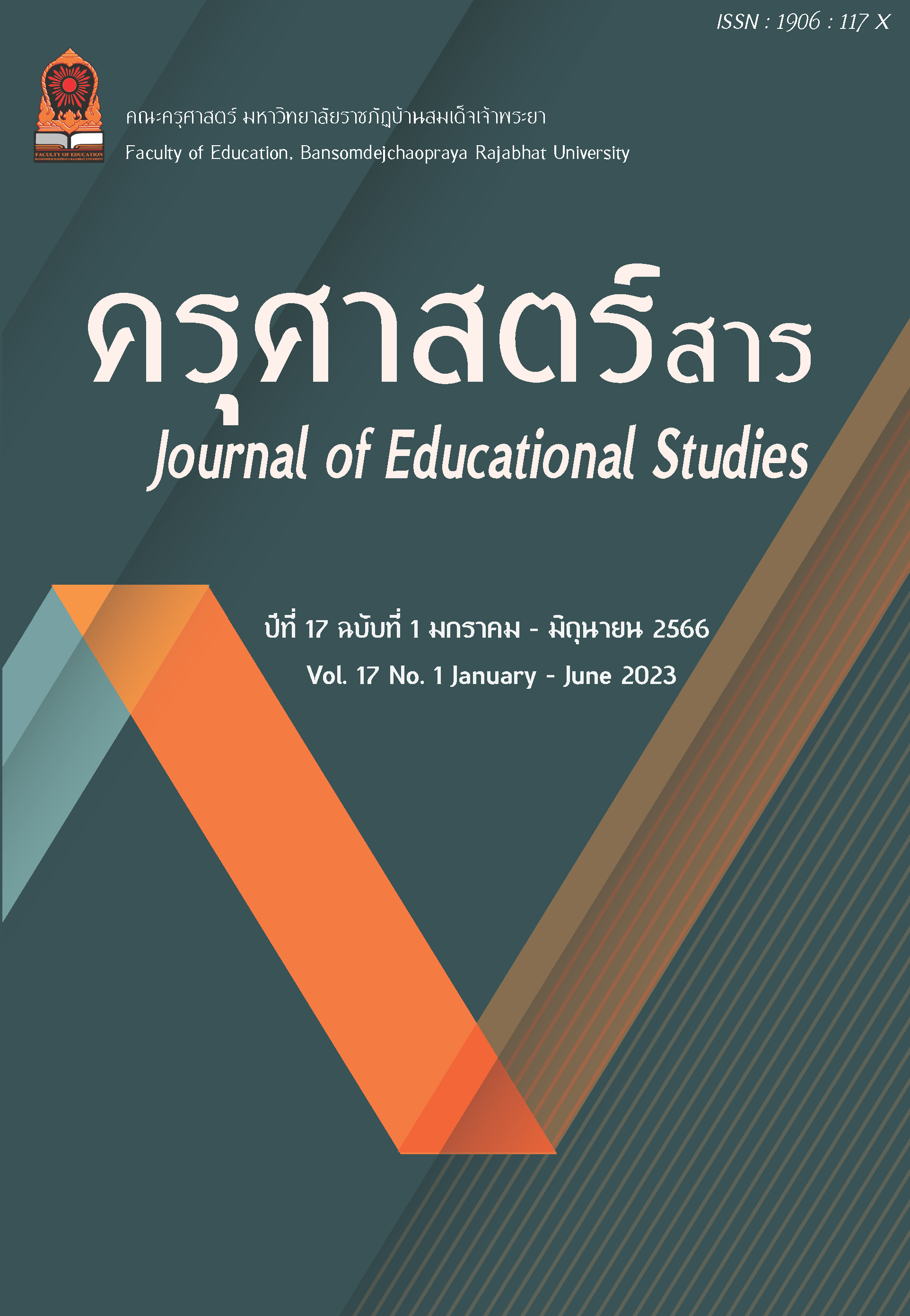แนวทางการส่งเสริมคุณลักษณะที่พึงประสงค์ของนักศึกษาอาชีวศึกษา ในยุคดิจิทัล : การวิเคราะห์ผลกระทบไขว้
คำสำคัญ:
การวิเคราะห์ผลกระทบไขว้, คุณลักษณะที่พึงประสงค์ในยุคดิจิทัล,, นักศึกษาอาชีวศึกษาในยุคดิจิทัลบทคัดย่อ
งานวิจัยนี้มีวัตถุประสงค์ 1) เพื่อวิเคราะห์คุณลักษณะที่พึงประสงค์ของนักศึกษาอาชีวศึกษาในยุคดิจิทัล และ 2) เพื่อนำเสนอแนวทางการส่งเสริมคุณลักษณะที่พึงประสงค์ของนักศึกษาอาชีวศึกษาในยุคดิจิทัล แหล่งข้อมูลที่ใช้ประกอบด้วย 3 แหล่ง คือ เอกสารและงานวิจัยที่เกี่ยวข้องในประเทศไทยและต่างประเทศ คุณสมบัติในการสมัครงาน และสัมภาษณ์ความต้องการของผู้ประกอบการ ได้มาจาก การประยุกต์ใช้คราวด์ซอร์สซิ่ง (crowdsourcing).และการทำเหมืองข้อความ (text.mining).วิเคราะห์ข้อมูลด้วยการวิเคราะห์คำศัพท์ร่วม.(co-occurrence).โดยใช้โปรแกรม R และประเมินความเป็นไปได้ของแนวทางด้วยการวิเคราะห์ผลกระทบไขว้ (cross–impact.analysis).โดยผู้ทรงคุณวุฒิ จำนวน 5 คน
ผลการวิจัยพบว่า
1. คุณลักษณะที่พึงประสงค์ของนักศึกษาอาชีวศึกษาในยุคดิจิทัลที่ตลาดแรงงานต้องการร่วมกัน 10 อันดับแรก ได้แก่ 1) ความอดทน 2) รับผิดชอบ 3) ทักษะมนุษยสัมพันธ์ 4) ขยัน 5) ทักษะการใช้โปรแกรมพื้นฐาน 6) ซื่อสัตย์ 7) รักการบริการ 8) ใฝ่เรียนรู้ 9) ทักษะเลือกใช้เครื่องมือในงานอาชีพ และ 10) ทักษะการทำงานเป็นทีม
2. แนวทางการส่งเสริมคุณลักษณะที่พึงประสงค์ของนักศึกษาอาชีวศึกษาในยุคดิจิทัล พบว่า 1) ฝ่ายนโยบาย ไม่มีแนวทางที่ส่งผลกระทบทำให้เกิดแนวทางอื่น 2) ฝ่ายผลิตบัณฑิต มีแนวทางที่มีผลกระทบต่อแนวทางอื่น จำนวน 2 แนวทาง ได้แก่ (2.1) ครูจัดการเรียนการสอนให้เข้ากับบริบทของ การทำงานบนโลกดิจิทัลมากยิ่งขึ้น และ (2.2) ผู้อำนวยการสถานศึกษาพัฒนากิจกรรมเสริมหลักสูตรในเรื่องทักษะการทำงาน (future.skills) 3) ฝ่ายผู้ใช้บัณฑิต มีแนวทางที่มีผลกระทบต่อแนวทางอื่น จำนวน 3 แนวทาง ได้แก่ (3.1) ผู้ประกอบการจัด workshop.นักศึกษาก่อนทำงานและมีการประชุมนักศึกษาอย่างน้อยเดือนละ 1 ครั้ง โดยให้นักศึกษาได้ประเมินตนเอง (self-assessment).(3.2) ผู้ประกอบการเสริมสร้างการใช้เทคโนโลยีสารสนเทศ โดยมีอุปกรณ์เครื่องมือที่ทันสมัยและเพียงพอ และ(3.3) ผู้ประกอบการให้ความสำคัญกับผู้ควบคุมนักศึกษาในการฝึกประสบการณ์ โดยพัฒนาให้ผู้ควบคุมมีทักษะการโค้ช (coaching skill)
Downloads
เอกสารอ้างอิง
กระทรวงศึกษาธิการ. (2562). หลักสูตรประกาศนียบัตรวิชาชีพ พุทธศักราช 2562. สืบค้นจาก http://bsq.vec.go.th/Portals/9/Course/20/2562/newv1.pdf
กระทรวงศึกษาธิการ. (2563). หลักสูตรประกาศนียบัตรวิชาชีพชั้นสูง พุทธศักราช 2563. สืบค้นจาก http://bsq.vec.go.th/Portals/9/Course/30/2563/Commandv1.pdf
เกียรติ แดงสีดา, พิมผกา ธรรมสิทธิ์ และวจี ปัญญาใส. (2563).ยุคดิจิทัลกับแนวทางการบริหารแหล่งเรียนรู้ในสถานศึกษาสังกัดสำนักงานเขตพื้นที่การศึกษาประถมศึกษาพิษณุโลก เขต 1. วารสารมหาจุฬานาครทรรศน์,7(6). 45-59.
ณัฐสิฏ รักษ์เกียรติวงศ์..(2560)..การปฏิรูปอาชีวศึกษาของประเทศไทย. สืบค้นจาก https://tdri.or.th/ wp-content/uploads/2016/08/nuthasid-vocational-education-v02_2.pdf
Abdurakhmanova, G., Shayusupova, N., Irmatova, A., & Rustamov, D. (2020). The role of the digital economy in the development of the human capital market. International Journal of Psychological Rehabilitation, 24(7), 8043-8051.
Auld, E., & Morris, P. (2019). The OECD and IELS: Redefining early childhood education for the 21st century. Policy Futures in Education, 17(1), 11-26.
Choi, D. S., Sung, C. S., & Park, J. Y. (2020). How does technology startups increase innovative performance? The study of technology startups on innovation focusing on employment change in Korea. Sustainability, 12(2), 551.
Fareri, S., Fantoni, G., Chiarello, F., Coli, E., & Binda, A. (2020). Estimating Industry 4.0 impact on job profiles and skills using text mining. Computers in industry, 118, 103222.
Gaikwad, S. V., Chaugule, A., & Patil, P. (2014). Text mining methods and techniques. International Journal of Computer Applications, 85(17).
Gordon, T. J. (1994). Cross-impact method. American Council for the United Nations
University. Habtoor, N., & Alharbi, A. A. (2020). Importance of Human Factors to Organizational Performance. International Journal of Management and Human Science (IJMHS), 4(1), 11-22.
He, Z. (2021). Cross Platform Text Mining Based on Public Emergency—Using Word2 vec Model and K-means Algorithm. In 2021 IEEE International Conference on Artificial Intelligence and Computer Applications (ICAICA), (1-7).
Kantardzic, M. (2011). Data mining: concepts, models, methods, and algorithms. John Wiley & Sons.
Karachiwalla, R., & Pinkow, F. (2021). Understanding crowdsourcing projects: A reviewon the key design elements of a crowdsourcing initiative. Creativity and Innovation Management.
Lim, J. E., Lee, J., & Kim, D. (2021). The effects of feedback and goal on the quality of crowdsourcing tasks. International Journal of Human–Computer Interaction, 1-13.
Lodi, E., Zammitti, A., Magnano, P., Patrizi, P. & Santisi, G. (2020). Italian Adaption of Self-Perceived Employability Scale: Psychometric Properties and Relations with the Career Adaptability and Well-Being. Behavioral Science, 10, 1-18 https:// doi:10.3390/ bs10050082.
Sauli, F. (2021). The collaboration between Swiss initial vocational education and training partners: perceptions of apprentices, teachers, and in-company trainers. Empirical Research in Vocational Education and Training, 13(1), 1-22.
Thoben, K.-D., Wiesner, S.A., Wuest, T., (2017). Industrie 4.0 and smart manufacturing a review of research issues and application examples. Int. J. Autom. Technol. 11(1).
Xie, X., Fu, Y., Jin, H., Zhao, Y., & Cao, W. (2020). A novel text mining approach for Scholar information extraction from web content in Chinese. Future Generation Computer Systems, 111, 859-872.
Zhang, A. (2012). Peer assessment of soft skills and hard skills. Journal of Information Technology Education: Research, 11(1), 155-168.
ดาวน์โหลด
เผยแพร่แล้ว
รูปแบบการอ้างอิง
ฉบับ
ประเภทบทความ
สัญญาอนุญาต

อนุญาตภายใต้เงื่อนไข Creative Commons Attribution-NonCommercial-NoDerivatives 4.0 International License.
บทความที่ได้รับการตีพิมพ์เป็นลิขสิทธิ์ของคณะครุศาสตร์ มหาวิทยาลัยราชภัฏบ้านสมเด็จเจ้าพระยา
ข้อความที่ปรากฏในบทความแต่ละเรื่องในวารสารวิชาการเล่มนี้เป็นความคิดเห็นส่วนตัวของผู้เขียนแต่ละท่านไม่เกี่ยวข้องกับมหาวิทยาลัยราชภัฏบ้านสมเด็จเจ้าพระยา และคณาจารย์ท่านอื่นๆในมหาวิทยาลัยฯ แต่อย่างใด ความรับผิดชอบองค์ประกอบทั้งหมดของบทความแต่ละเรื่องเป็นของผู้เขียนแต่ละท่าน หากมีความผิดพลาดใดๆ ผู้เขียนแต่ละท่านจะรับผิดชอบบทความของตนเอง



